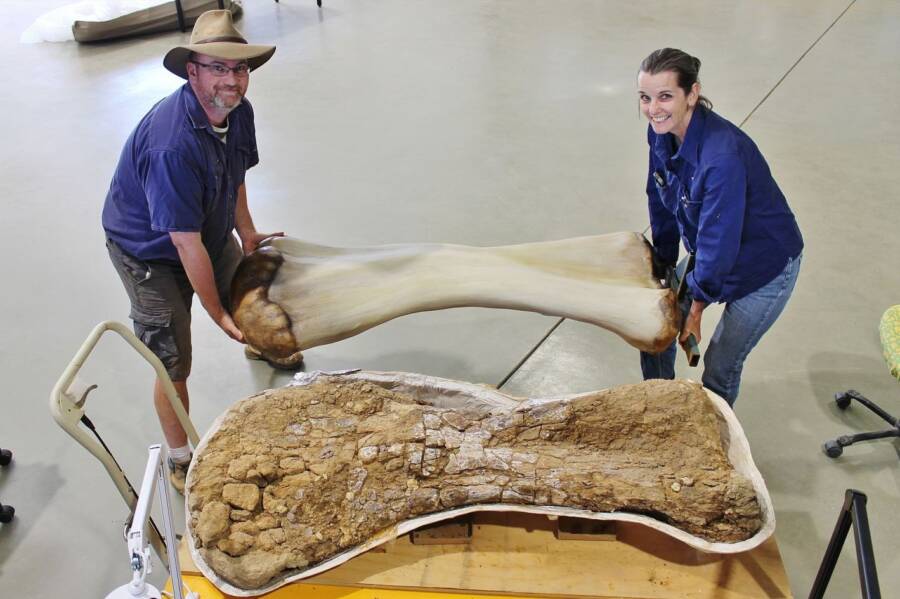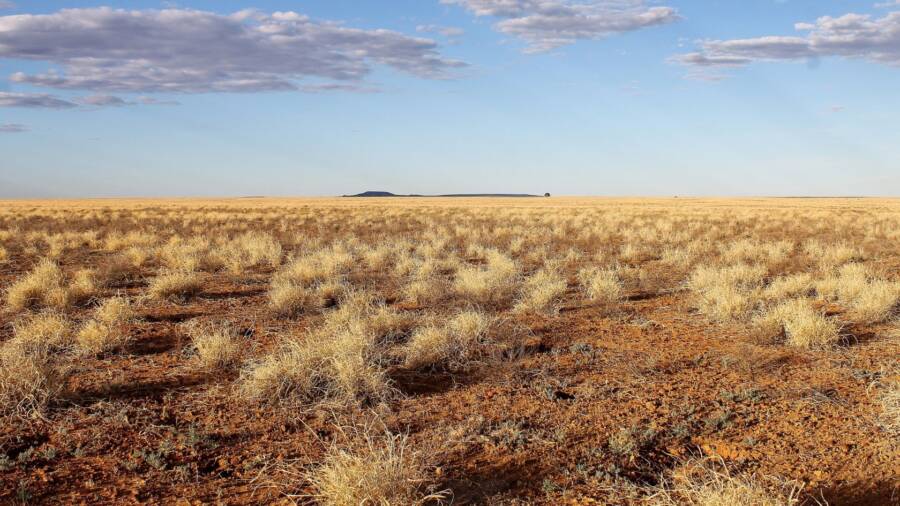

Eromanga Natural History MuseumAn illustration of the 98-foot-long behemoth in its element.
Sandy Mackenzie was only 14 years old when he stumbled upon the curious fossil. Right beneath his feet in the Winton Formation of Queensland, Australia was the bone of a dinosaur that roamed the Earth between 92 and 96 million years ago. Far more astounding than its age, however, was its colossal length of 98 feet.
That staggering figure made the newly classified Australotitan cooperensis longer than a standard basketball court, according to NBC News. The prehistoric titan also stood as tall as 21 feet, and has officially become the biggest dinosaur ever found on the continent — and one of the 15 largest ever discovered by mankind.
The teenager who found it was the son of Eromanga Natural History Museum director Robin Mackenzie, according to LiveScience. In 2007, she and paleontologists from the Queensland Museum finally excavated the creature, and this month, the scientists published a study laying out just how massive it was.
“In Australia, it’s certainly the largest animal that’s ever walked the Outback,” said Scott Hocknull, co-author of the study and Queensland Museum vertebrate paleoecologist. “This is huge. This is a fantastic beast. Imagine something the size of a basketball court walking around on land.”

Rochelle Lawrence et. alScott Hocknull and Robyn Mackenzie carrying a 3D reconstruction of the dinosaur’s humerus.
Discovered on a farm near Cooper Creek in southwest Queensland, the plant-eating sauropod has been endearingly dubbed “Cooper” or “the southern titan,” according to NPR. Paleontologists from both the Eromanga Natural History Museum and Queensland Museum worked together to study, classify, and research the findings.
As for properly classifying the dinosaur, the experts created 3D scans of every recovered bone and compared them to those of other known sauropod species around the world. They discovered rather quickly that the Australotitan was larger than anything else in Australia — and a formidable global challenger.
“Australotitan adds to the growing list of uniquely Australian dinosaur species discovered in Outback Queensland,” said Hocknull.
Sauropods are vegetarian dinosaurs with long necks that allow them to reach into the tallest treetops, while four hefty legs carry them around and a long tail swings around behind. Paleontologists were eager to compare “Cooper” to other sauropods.

Rochelle Lawrence et. alThe outback site where the fossilized dinosaur bones were first discovered.
“The 3D scans we created allowed me to carry around 1000s of kilos of dinosaur bones in a 7 kilogram [15.4-pound) laptop,” said Hocknull. “Better yet, we can now share these scans and knowledge online with the world.”
By comparing their findings to those of other dinosaurs, researchers discovered that the Australotitan was closely related to three other sauropods that roamed the outback. While there were definite genetic links to the Diamantinasaurus, Savannasaurus, and Wintonotitan, none of them were even remotely as large.
“We found that Australotitan was the largest in the family, followed by Wintonotitan with big hips and long legs, whilst the two smaller sauropods, Diamantinasaurus and Savannasaurus were shorter in stature and heavily-set,” said Hocknull.
Aside from its 98-foot length from snout to tail and taller stature than any animal on the planet, the Australotitan weighed between 25 and 82 tons. In order to properly gauge just how substantial that is, the creature’s maximum weight was about as heavy as Boeing 757 airplane.

Eromanga Natural History MuseumRobyn Mackenzie with the actual Australotitan Cooperensis fossils.
Astonishingly, unearthing the Australotitan was only the beginning. Recent discoveries in Queensland have yielded a rocky outback area covering more than 300 feet of ground which Hocknull said “represents a sauropod pathway, where the dinosaurs walked along trampling mud and bones into the soft ground.”
Unfortunately for “Cooper,” some of his bones were found crushed — suggesting that his final resting place remained heavily trafficked by sauropods traversing the same terrain. Fortunately for Hocknull and Mackenzie, some of their fossilized footprints were discovered on that pathway as further remnants to study.
“Discoveries like this are just the tip of the iceberg,” said Hocknull. “Our ultimate goal is to find evidence that tells the changing story of Queensland, hundreds of millions of years in the making.”